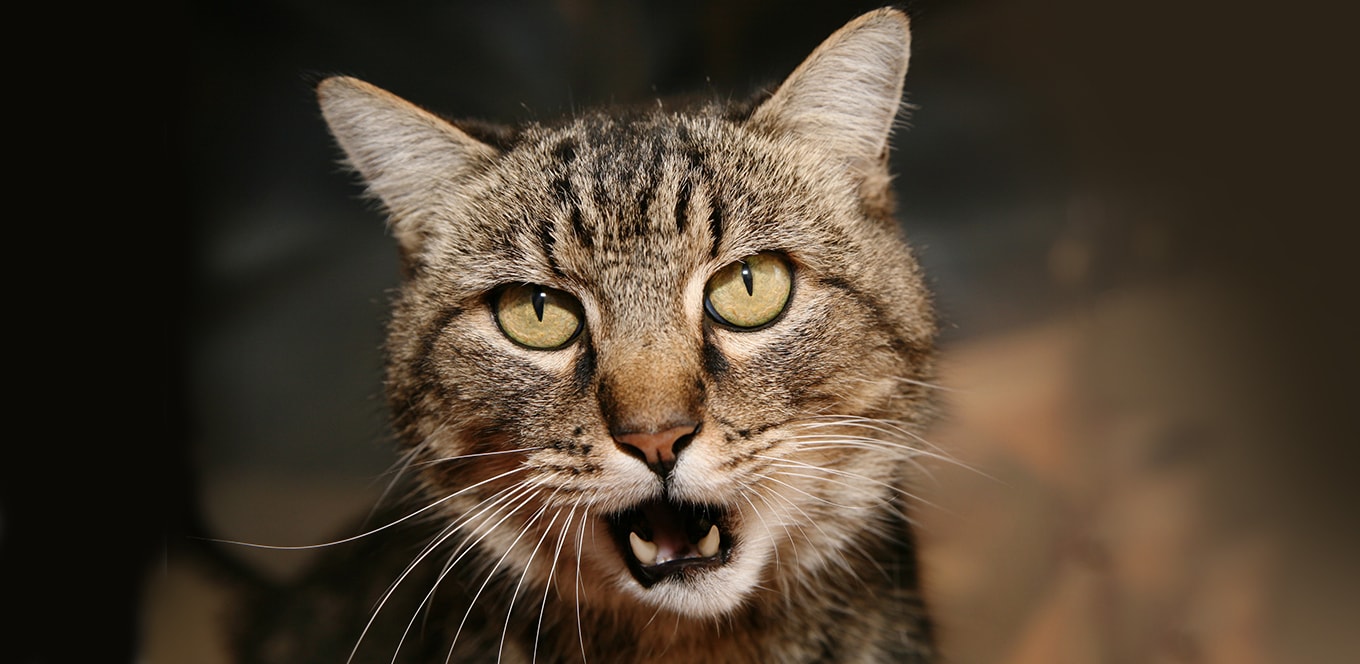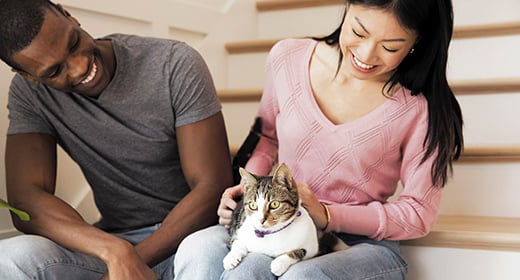

Listen up, Mom or Dad, because your feline definitely has something to say. Cats use more than 100 different vocal sounds to communicate. Here are nine of the most common sounds you’ll hear and what your cat’s unique language means.
While your cat’s purrs are usually a sign that they’re happy, comfortable or content, it’s important to point out that your cat might also purr when they are anxious, agitated or sick — because purring soothes them. The key to figuring out if it’s a “worry purr” is to check if their ears are folded back, if they seem tense or if they just aren’t acting normal. (If that’s the case, call the vet and grab the cat carrier.)
Why do cats meow? It’s simple: It’s their way of communicating with us!
Meows are your cat’s most common “word,” and every one means something different. For example, your cat might meow to greet you when you come home, to ask you to open your bedroom door so they can curl up on your pillow, or to say, “I’d like some more tasty kibble or a second serving of IAMS® PERFECT PORTIONS™ paté, s’il vous plaît.”
Chirps and trills are the loving language of cat mothers. Chirps, or chirrups, are staccato, bird-like sounds mother cats use to say to their kittens, “Follow me.” Trills are higher-pitched chirps your cat uses to say hello or “Pay attention to me.” When your cat directs these sounds at you, chances are they want you to give them some love or follow them somewhere, usually to their food or water bowl. (Shocker, LOL.)
If you have more than one feline fur baby, listen closely. You’ll likely hear your cats talk to each other with these sounds.
When your kitty spies an unsuspecting bird or squirrel frolicking outside the window, they might make a chattering sound at it. This distinctive, repetitive clicking noise is caused by a combination of lip smacking and your cat rapidly vibrating their lower jaw. This odd behavior looks like teeth chattering, and a lot of cats also chirp when they chatter.
This clickety sound is thought to be a mix of predatory excitement and frustration at not being able to get to the elusive feathered or furry prize. Some animal behaviorists even think the sound mimics a fatal bite used to break the bones of their prey. Who knew your li’l feline was so ferocious?!
Regardless of the exact reason cats chatter or chirp at birds and other small animals, most feline parents find it fascinating and amusing to watch.
The unmistakable sound of a cat hissing is like a steak hitting a hot skillet, and it can only mean one thing: Your cat feels threatened and will put up a fight if they have to. Just as important as the hissing sound, however, is the cat body language that comes with it. Your cat will flatten their ears, arch their back, puff their fur, twitch their tail and usually open their mouth to flash their fangs — aka the classic defensive pose.
In addition to a hiss, if your cat makes a deep, guttural growlsound, they’re saying, “Back off.” Similar to a dog’s growl, this noise means your cat is annoyed, scared or angry. Some cats even make short, higher-pitched snarl sounds before launching into a full-blown growl.
While these sounds usually signify an unhappy cat, it’s important to note that some cats growl because they’re in pain from an injury or a health problem. If you suspect this is the case, a trip to the vet is in order.
If your feline snarls or growls at you for any reason, though, it’s best to leave your feisty friend alone.
A yowl, or howl, is a long, drawn-out meow that almost sounds like moaning; it’s your cat’s way of telling you they’re worried or distressed, or that they need you. They might have gotten locked in a closet, can’t find you anywhere or, heaven forbid, have discovered their food bowl is empty. Your cat might also yowl when they don’t feel well or when a new neighborhood cat trespasses on their turf.
Whatever the reason, make sure you immediately help your cat whenever you hear a yowl. Trust us — you’ll both be glad you did.



Bringing a kitten home is an experience full of joy and warmth. The internet is filled with kitten photos and videos, and you are soon going to find out why! However, these cute creatures are extremely delicate and need hands-on attention while growing up. If you bring home a kitten without a mother, you will have to be extra careful with it. Every cat parent should be well-informed about how to take care of newborn kittens or kittens in general.
We have put together a few tips to get you started on your journey of raising a kitten. From vet visits and food selection to grooming and keeping it hydrated, this article will give you a basic understanding of how to take care of a kitten.
Routine check-ups are highly recommended for kittens. Once you get a kitten home, your responsibility as a caregiver is to take it to the vet for a basic health check-up. During this check-up, the veterinarian will check for any health concerns that need to be addressed immediately. They will also walk you through the vaccination and spaying/neutering process. If you are a first-time cat parent, do not hesitate from asking doubts and questions regarding your cat’s health and well-being.
Since a dehydrated kitten can be vulnerable to many diseases and infections, make sure that fresh water is easily accessible. In fact, place multiple water bowls around the house for it to drink from. Clean these bowls regularly and fill them up with fresh water. If the vet recommends, you can also give your kitten electrolyte water.
A newborn kitten should be fed by its mother for the first few weeks. However, kitties that find a new home generally get separated from their mother at an early age. If you have adopted a newborn pet, you probably do not know how to take care of a kitten without a mother. Start by visiting a vet to receive a comprehensive feeding guide. It will help you meet the kitty’s nutritional needs. You might also have to switch to a different type of food at different stages like teething.
Cats are carnivores; hence, their food intake is majorly meat. Ensure that the dry food you give your cat is made with high-quality protein. Made with chicken as the main ingredient, IAMS Proactive Health Mother and Kitten is a protein-rich meal option for your kitten. This kitten food also contains Omega 3, Colostrum, and DHA to support healthy eye and brain development!
Cats are independent creatures that enjoy their space. However, from time to time, they also like being cuddled and picked up. They will also show affection in their own unique ways. Give your kitten some time to settle in and gradually start introducing it to your touch. Gently hold it and pamper it. Bring a few fun toys for it to play with. Kittens generally love playing with bells, strings, or anything that they can chase.
Taking care of a kitten involves introducing it to its new family members – including other pets – from the day it is brought home. After all, your new kitten will be the newest addition to the clan! If you are worried about your dog and cat not getting along because of age-old assumptions, let us assure you, it is nothing but a myth. However, some dogs may not be able to differentiate a cat from a rabbit and their prey instincts could kick in. If this happens, you need to train your dog by familiarising it with your kitten’s scent. Most dog breeds are hostile in nature and can coexist with other pets easily. Socialising for your kitten will also include grooming days, check-up days, and more.
Cats love grooming themselves and are very particular about how they look. However, kittens may need some help, especially in cases where they dirty themselves. Your vet will educate you about ways in which you can give your delicate and tiny kitten a bath. Post that, brush your kitten’s fur coat. Now, brushing its coat does not only remove dirt and dead hair, but it also regulates blood circulation, giving your kitty a healthy glow!
Litter training is one of the most important aspects of raising a kitten. Choose a litter box that is big enough for your kitten to do its business. Finding the right type of litter may take some experimenting, but you will soon get there! Fortunately, cats usually eliminate in sandy or granular places by nature. So, when you introduce it to a litter box, chances are that it will use it right away. If your feline friend doesn’t, give it some time to get comfortable. Keep cleaning the litter box periodically to ensure hygiene.
As a cat parent, you must pay attention to your kitty’s sleeping space. Kittens and cats are heavy sleepers; kittens can even sleep for 20 hours a day! For the first few nights, make sure your kitten sleeps next to your bed. It is normal for these feline creatures to cry during the first few days as everything is new. However, your kitten will eventually start getting used to its new space and sleep for long hours. Once it starts doing that, you can set up a cosy corner for it to sleep in. If you are wondering how to take care of a newborn kitten, just make sure that you place it somewhere near your bed. This will help you hear any cries and come to their aid as soon as possible.